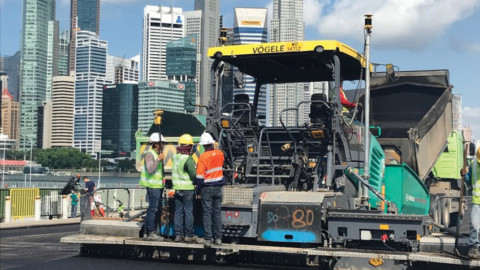Surface deterioration is one of the major problems that can affect the service life of a bridge. Bridges are subject to a number of damaging elements, causing them to crack prematurely due to shrinkage, movement, and wear and tear. If not properly protected, moisture and chemicals can penetrate into the structure over time, leading to corrosion and degradation of the structure.

“When choosing a waterproofing membrane for bridge decks, there are several factors that need to be taken into consideration.
“Membranes need to be strong enough to protect the bridge deck from the harshest weather conditions at the location. Bridges are also constantly moving, therefore the membrane must also be flexible, in order to withstand traffic loads and accommodate cracks, while maintaining its bond to the bridge surface.
“If it’s unable to withstand these pressures it can crack and peel, allowing moisture and chemicals, such as oil and petrol, to get through the membrane, which will lead to corrosion if ignored,” Mr Bauer said.
Protect your assets
According to Mr Bauer, waterproofing membranes such as Hychem’s Polyac PMMA systems are ideal for protecting bridge decks.
“Poly(methyl methacrylate), or PMMA, is the best fast curing concrete waterproofing system available. It’s rapid-curing, easy to apply and extremely durable.
“It’s ideal for bridge decks as it’s suitable for harsh and cold climates, impervious to moisture, resistant to chemical attack and is UV stable. It’s also flexible and won’t crack when applied to unstable surfaces such as bridges.”
First developed in Europe, PMMA has been used successfully to waterproof and protect bridge decks for many years on a variety of surfaces including concrete, wood, asphalt, old bituminous membranes and steel.
“One of the main advantages of PMMA membranes is that they are fast-curing and have high reactivity, allowing for the application process to be completed at low temperatures, and with minimal downtime. With this technology, traffic doesn’t need to be disrupted for extended periods of time. Once applied, regular service can recommence within hours,” Mr Bauer said.
Bonding together
PMMA also has bonding advantages over regular epoxies and polyurethanes when used on bridge decks.
Regular epoxies and polyurethanes are unsuitable as waterproofing membranes on steel structures, as the coating is unable to stay bonded to the steel and begins to delaminate. This process accelerates when there is excess moisture and extreme temperatures.
When applied to concrete, bridge surfaces need to be properly prepared in order for the product to bond to the surface, which can be too time consuming and difficult to complete on structures such as bridge decks.
“On the other hand, PMMA coatings chemically bond well to steel and concrete, which prevents delamination and gives them a long life expectancy.
“They can also be applied on unprepared surfaces, eliminating the need for aggressive mechanical preparation, such as diamond grinding, reducing downtime and making re-coating and maintenance quick and easy,” Mr Bauer said.
“Once cured, PMMA membranes are seamless, highly durable, and resistant to heavy traffic and extreme temperatures.”
PMMA products can also be customised to incorporate different properties such as impact and chemical resistance, and flame retardancy.
“Our Polyac PMMA systems are versatile and can protect bridge decks from moisture and chemical attack, extending its life,” Mr Bauer said.
A durable solution
Hychem’s PMMA systems have been proven to provide long-lasting protection against deterioration of bridge decks and other infrastructure assets in the harshest of conditions.
This partner content is brought to you by Hychem. For more information, visit www.hychem.com.au, or call 02 4646 1660.
















